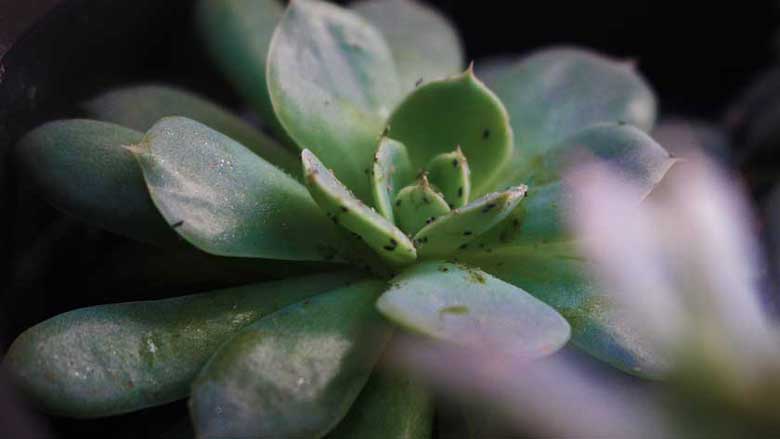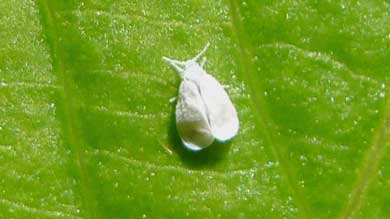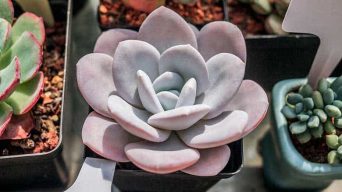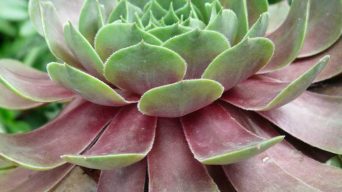Houseplants are a great way to add natural beauty and life to any home. But did you know that plants can attract a wide variety of insects?
Succulents are popular plants that have a reputation for being low-maintenance plants and pest resistant.
But do succulents attract bugs?
Succulents do attract bugs as all other houseplant varieties do. Insects will find succulents attractive because these types tend to emit water via their leaves. They also secrete salt when wet, which is another available food source found within reach of bugs at all times.
Here we will explore that question and provide some helpful tips on how to keep your Succulents bug-free.
Why Do Plants Attract Bugs?
Plants attract bugs for a variety of reasons, some more obvious than others.
Insects are drawn to flowers and fruits by the sweet fragrances they release into the air when blooming or ripening.
This is an instinctive response on behalf of these animals who need to find food sources and mates.
Pests will thrive in any environment that is supportive of them. They need three things to survive: food, water, and shelter.
Succulents and Cacti may attract bugs because they have a waxy coating on their leaves or needles.
This is attractive for certain insects which prey upon them by sucking out the sap they exude from small holes made to feed themselves.
These tiny creatures will happily make homes among your potted indoor plants if given access via carelessness with watering practices, as well as leaving the plants unwatched for too long.
How To Know If Your Succulents Are Infested With Bugs
It’s not always easy to know if your succulents are infested with bugs, but there are some tell-tale signs.
Some things you can do to know if your succulents are infested are:
Check For Signs of Bugs
Common signs of plant pest infestations are damages in leaves, gnawing on stems and buds, or the discovery of bugs themselves.
If you find signs of houseplant bugs, examine the plants closely to see if there are specific kinds.
When you find a bug, it is crucial not only to remove it from your plants but also all the eggs that have been laid down.
Check For Damage to Leaves, Flowers, or Stems
If you find damage to leaves, flowers, or stems, an insect may have damaged the plant.
Damage may not always be visible on succulents because they need less water and are often in dryer climates than many other plants.
This means their surfaces can have a hard time retaining moisture so that any injury will show up more quickly.
This makes them susceptible to diseases like fungus infections, for instance (especially if there’s been humidity).
Look For Webs or Cocoons in the Soil
If you find webs or cocoons, then the plant may have been infested with spider mites.
Spider Mite damage will be visible as “spider-webbing” on leaves and stems.
They will also show a lack of vigor, yellowing/brown spotting (especially between veins), and slow growth in general.
Spider Mites suck out all their nutrients from your succulent’s roots.
If there is more than one type present at once, this can result in weak stems breaking off easily.
This means less water retention for them overall, so make sure not to let these pests go unnoticed!
Look At The Succulent’s Roots
If you’re still not sure if your plant has pests, examine the roots for signs of over-crowding or discoloration.
These are both potential indicators that there may be a pest problem going on.
If there are pests on the roots, it’s best to treat them as soon as possible.
They will move up through your plant and cause more damage.
Examine the Soil for Signs of Bugs or Eggs
Another thing to look at is the soil. Is there any evidence of pests? If you notice eggs or larva, you’ll want to treat those as soon as possible.
You should also observe if there are any pests on top of the soil and remove them quickly.
What Kind of Bugs Do Succulents Attract?
The most important thing to do is identify the problem before it becomes a larger, more serious one.
The best way of doing so? Get to know your bugs!
Below are some of the most common pests you will need to watch out for.
Vine Weevils
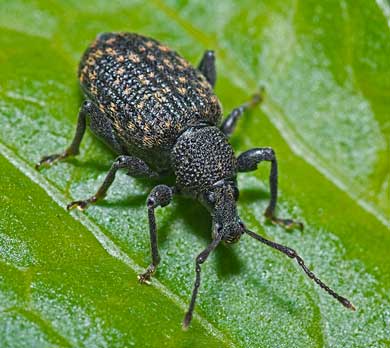
One type of insect pest that you may encounter is vine weevil.
Frequently these are found in greenhouses or gardens with many succulents and vegetables, so it’s important to know what they look like.
Vine Weevils typically have a light brown body about ¼ inches long (about the size of an adult thumb).
They also hop when moving on leaves instead of crawling around plants, as other types tend to do.
You may also notice small holes at the top of leaves on your succulents.
This is because, as their name suggests, these bug eats from plants by weevil through them until it reaches its destination and lays eggs inside, sometimes resulting in death to a plant’s host.
For this reason, you’ll be able to find many vine worms around stems or roots where they are the most vulnerable spot for an attack as well.
How To Get Rid Of Vine Weevils on Succulents
There are a few ways to get rid of vine weevils on succulents.
One way is by using an insecticidal soap that you can buy at most garden centers, which dries the bugs out and kills them in about six hours.
You could also use neem oil or para-dichlorobenzene (PDB), both natural pesticides with little toxicity when applied correctly.
Finally, another option would be getting some beneficial bugs like ladybugs – they eat other pests as well, so it’s double-duty protection.
Just make sure not to have many around your houseplants. These buggers have been known to spread diseases among themselves if their populations grow high enough.
Mealy Bugs
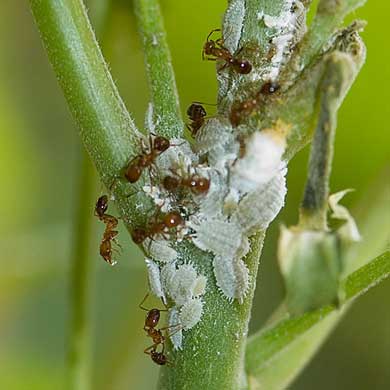
Mealy Bugs are a common pest on succulent plants.
These bugs feed on the sap of plants, which disrupts their growth and stunting them to an ugly state.
The Mealybug’s favorite types of succulents include cacti, Echeveria, Sedum, and more.
A Mealybug infestation is difficult to control. This is why succulent owners need to check their plants periodically and carefully choose where they place them in the home.
Leaving these pests untreated can lead you into an even worse predicament with infestations of spider mites and aphids!
How To Get Rid Of Mealybugs on Succulents
If you notice that your succulent has Mealybugs, the best thing to do is remove all of them.
You can use a cotton swab dipped in alcohol or rubbing alcohol and wipe off any webbing from stems.
Alternatively, there are insecticidal soaps that will kill mealybugs on contact.
However, when it’s just one plant with only a minor infestation, this may not be necessary as using pesticides frequently could harm other plants nearby.
Spider Mites
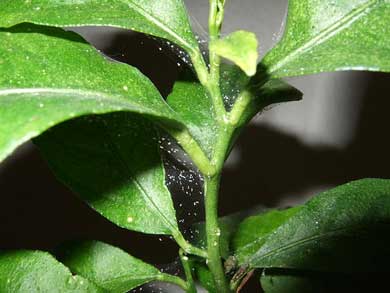
Spider Mites are the most common insect problem for succulents.
They feed on plants and can cause stunting, leaf drop, the appearance of a webbing substance from above-ground plant parts (spider webs), discoloration, or death of young leaves at edges.
Adult spider mites are less than 1/20th inch long with eight legs. They range in color from red to yellowish-brown to black, depending on their age and species.
Spider Mite eggs hatch within two weeks as adults and search out new food sources once feeding has stopped over winter.
Damage caused by these insects is usually insignificant but, if left unchecked, will continue until your prized succulent becomes nothing more than spindly sticks!
How To Get Rid Of Spider Mites on Succulents
One way people recommend getting rid of spiders from their houseplants involves placing an infested pot inside another container together filled up halfway with water.
- Remove the plant from its pot and place it in a jar of water (this will drown any bugs hiding out on your succulent.) Once you’ve submerged all parts, shake well to make sure no insects remain. If there are still spider mites present, repeat this step once again.
- After soaking, remove plants carefully without disturbing the soil too much. Rinse well until cold tap water runs clear while gently shaking.
- After a few rounds of shaking out the dirt under cold water, inspect carefully, looking at all surfaces, including leaves’ undersides. Also, examine the roots that should look healthy, so something small like an old leaf doesn’t go unnoticed!
- Finally, place back into the soil gently, but do not move any more than necessary because this could cause irreparable damage that will lead to death.
Scale
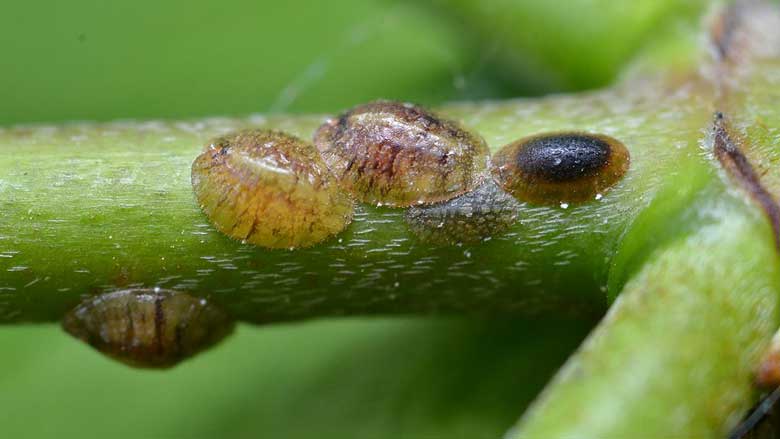
Scale bugs are a common problem for succulents. These tiny insects will quickly infest your plants, causing damage and sometimes death to the plant if not dealt with promptly.
The Scale insect can be found on many different types of plants, including cacti, houseplants, or other garden-type vegetation.
You can identify the scale on succulents by gently rubbing the plant leaves.
There is an easy way to know what type of insect it is.
Scales, contrary to aphids, have a hard outer shell that will not allow water droplets from your fingers or spray bottles to penetrate and suffocate them.
Their bodies become stickier as they feed off sap in new growth areas.
How To Get Rid Of Scale on Succulents
There are many ways to get rid of scale on succulents.
The first thing you want is a spray bottle with soapy water, dish soap, or vegetable oil in it. Then some paper towels for wiping the plant off after spraying them down (or whatever material works best).
You can also purchase insecticidal products at your local garden center. They come as an aerosol that needs careful application around all new growth areas where feeding takes place.
Avoid direct contact unless instructed otherwise because this could burn delicate plants.
A more natural way would be using neem oils mixed into food-grade liquid paraffin wax.
If applying these mixtures directly onto bare roots, do not apply too much pressure when rubbing against their surface since they may have a protective coating.
Whiteflies
Although whiteflies are not the most common bug found on succulents, they can be a nuisance.
Whitefly scale is an insect that sucks sap from leaves and stems of plants causing damage to all areas it infests, including your favorite houseplant or cactus.
You will know if you have them because these pests leave behind small yellowish powdery spots called honeydew.
These spots attract other bugs like ants who feed on this sticky substance left by their droppings.
How To Get Rid Of Whiteflies on Succulents
It is essential to take action right away when you see these little pests on your succulents to not let them spread.
A simple way of getting rid of whiteflies without using harmful chemicals that are toxic for humans and plants involves natural products like cedar oil soap.
All that is needed with this method is to add a few drops mixed with water and spray them on the leaves where they have been found, followed by a thorough rinse under running tap water.
Otherwise, if possible, allow some time before wiping off any residue left behind after drying out completely.
Then apply another round of treatment as needed throughout the day until the problem disappears.
Slugs and Snails

Slugs and snails are often a problem in succulents gardens.
This is because the plants attract these pests with their moist surface. They leave traces on all leaves, which can be unsightly and harmful to plants when they eat or suck their juices, so it’s best to monitor your gardens closely if you notice any presence.
How To Get Rid Of Slugs and Snail on Succulents
If you see any slugs or snails on your succulents, try adjusting the soil to make it less moist.
This will give them fewer places to hide and feed on plant life nearby. It also gives plants a better chance for surviving their attack without being completely obliterated by these pests.
If you notice that the slug and snail problem persists, try using a sprayer or an old toothbrush to scrub away any pests gently.
For more severe infestation cases where there are too many slugs on your succulents, remove them manually without damaging the plants with pesticides.
Fungus Gnats
One of the most common and destructive pests found on succulents are Fungus Gnats.
These tiny, black flies typically lay their eggs in moist soil or around the base of plants.
They will hatch as larvae and feed off plant roots with a voracious appetite for up to six weeks before pupating into an adult fly.
Fungus gnat larvae are challenging to spot, but an easy way of knowing if you have them is by checking the soil or leaves for a mass that’s either white, black, and yellowish.
How To Get Rid Of Fungus Gnats on Succulents
If you have already spotted the larvae, it’s vital to take action as soon as possible.
The best way of getting rid is by using a systemic pesticide.
It will not only kill off any pests in your soil or on leaves but also prevent future infestations from happening again.
If there are no other plants around the succulents, then spray and repeat once every two weeks until signs disappear entirely.
This should be necessary if heavy rainfall has occurred since treatment was last applied, which could lead these flies back into root zone areas undetected otherwise.
Aphids

Aphids are small, wingless insects found on the leaves of succulents.
They use their piercing-sucking mouthparts to suck out fluids from plants and cause damage by secreting a sticky substance called honeydew.
This is an attractive feeding ground for ants, protecting aphid colonies in return for this sweet good!
These tiny pests also produce live offspring without mating. Females lay eggs one at a time, but some species will even give birth to up to 300 nymphs per day.
Getting rid quickly becomes necessary before they multiply too much.
How To Get Rid Of Aphids on Succulents
There are several ways to get rid of aphids from your succulents.
Aphids can be killed by spraying them with water or rubbing the leaves in soapy dish soap, killing their protective wax coating.
For an Aphid infestation, some people prefer using Insecticidal Neem Oil, Horticultural Oils, and other types that may require re-application until they are eradicated.
Other methods include: putting up a beneficial insect, as ladybugs (their natural predators), near plants they frequent.
Ants

Ants on succulents are a common sight in most gardens.
Several different types can be found, including leafcutter ants and carpenter ants.
Leafcutter ant colonies will take sections of leaves to their nest, where they will use them as food for the larvae.
Carpenter ants live underground or inside houses during dry periods because it is wetter there than outside.
But venture out when rain falls if necessary due to increased activity searching for water sources such as dripping faucets and leaky pipes.
Carpenter ants come back day after day looking for any chance to get inside.
How To Get Rid Of Ants on Succulents
There are a few ways to keep ants away from succulents.
The best way is by using an ant trap that will attract the pests and kill them when they enter it.
Ant traps also protect plants other than just your cacti or aloe vera.
Other non-chemical methods include planting mint near succulent pots, which have a strong scent that ants don’t like.
Sprinkling cinnamon on the ground also works, which will put them off with its smell and taste.
Final Thoughts
Having plants means having to deal with bugs. And succulents are no exception.
Succulents attract bugs in the sense that they can be a food source for them.
Fortunately, there are a few things you can do to prevent and manage these houseplant pests.
But in the end, when it comes to protecting our plants from bugs, the best we can do is to recognize an infestation early so that it doesn’t get out of control.

